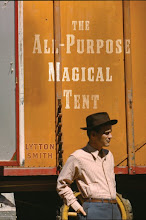I'm currently reading various poets associated with the L=A=N=G=U=A=G=E magazine and "Language School," whom I'm resisting calling Language poets not only because where does that leave everyone else? but also for some of the reasons well articulated by Barrett Watten on his blog/homepage. I'm reading these works under the aegis/direction of Michael Golston. Each week we're asked to provide some writing in response to the work we're reading for that class. These assignments offer me the chance to experiment with the style, form, and limits of critical writing, a practice that of course owes a debt to the writing included in L=A=N=G=U=A=G=E . Here's some thoughts on Susan Howe, particularly in response to her book Singularities .
1.
Maybe this does not belong here. (To be continued…)
2.
I have been mis-reading Susan Howe—as one is meant to. Thorow becomes Thoreau becomes Thor, row becomes (almost) throw, possibly thorough, possibly through. The text re-reads its authors’ (author + reader+authors read = authors’/author’s) reading & transcribing of a word.
It is in this sense, among others, I think about Howe as a poet of typography and topography: writing the landscape of the page (“The Frames should be exactly / fitted to the paper, the Margins / of which will not per[mit] / of a very deep Rabbit”) thorow writing the particularities (particle-uarities) of words.
3.
“Thus, how do we read what is meant precisely to be read? That is given for not other purpose, and without distraction […]. Wordsome.” Bruce Andrews, “Text & Context,” Paradise & Method: Poetics & Praxis, p. 7.
4.
Susan Howe is a poet and critic. What does this sentence tell me? That she writes poetry and that she writes criticism. In the past, and at times now still, I would have assumed that she is writing two things: poetry, one thing, criticism, one thing. Singularities (as well as My Emily Dickinson and possibly Souls of the Labadie Tract) offers to recategorize them as one thing, as spectrum rather than binary. This is especially true if the term critic is not restricted to the literary: Susan Howe is a critic who reads Lake George, New York. “After I learned to keep out of town, and after the first panic of dislocation had subsided, I moved into the weather’s fluctuation.” I was not expecting what she moved into to be anything other than an alternative to the “cabin off the road to Bolton Landing.” As a critic does, as a poet does, Howe has reconceived the world and most importantly the assembly of the world for me: moved, into, weather’s fluctuation – these I understood, experientially and theoretically, already; their construction, causality, togatherness I had not.
Susan Howe has also been a painter. Susan Howe has also been an assistant stage designer. I want to conclude that Susan Howe has been a painter of stage scenery, to keep her biography’s language in motion as she is keeping language in motion. In motion: unresolved. Possibly exhibiting unreadability. “ ‘Unreadability’ – that which requires new readers and teaches new readings.” Bruce Andrews, “Text & Context,” Paradise & Method: Poetics & Praxis, p. 7.
5. How we read what is meant precisely to be read: a list of substitutions provided by the brain, an interruption somewhere along the page-word-subway car air-eyeball-iris-brain that is the material of the world entering the mind as abstract, or so Aristotle said (in a fashion). The following list to be otherwise called “Single Rarities”:
Mustketsquid. (p. 41). Language of the prairie (p. 36). Weather in history and haven (p. 37).Sigh by sea (p. 22). Token (p. 38). etc.
I sometimes find myself reading Howe for the membrane between the word on the page and the word that could have been on the page, thinking of a membrane—the skin, say—as what conducts rather than what barriers. Catcht (caught, catechized) as I am, in the channels of word-osmosis, reading what I imagine to have been almost on the page, allowing what is on the page to remain there, mistaking what is on the page for what I thought was on the page.
7. (…as promised). This criticism belongs (longs for, but extremely so, the difference between a loved and a beloved) where? Or, in other terms, how do we write a criticism of the new poetics that isn’t in the traditional (read: expected; read: expected by who(m); read: for what group with what traditions?) manner. At what point does Andrews’ criticism become a poem (cf. “Suture”) and Howe’s poem become criticism, since each is shuttling between both stations though I know “Text & Context” as criticism in a way I do not initially know “Suture” as criticism and have to come to know it as such, rethinking what I want for and from criticism and poetry in the process, in process.
In what terms do we want the new poetries (some of which are new only to us, some quite old now, some still newer than newly written poetry in the old models) to be conveyed, especially where the reader is rushed, defensive that this is Poetry (and we must GET poetry, we were told, must PARSE poetry, must LEARN AND ROTE it, LEARN AND ROTE it, must UNDERSTAND, we were told, told wrongly). How much work can the criticism ask of the reader? Or, to put it another way, what is vitally lost when the criticism doesn’t ask of the reader a form of work—a radical reconceiving and reconceptualizing of world that would allow for social, political, economic, spiritual, chronological, historical, etceterical revision—that the poetry itself does?
7. Da capo al fine, but with criticism for poetry, poetry for criticism, critic for poet, poet for critic. (I mean also that the critic must be for, in support of, the poet.)
Tuesday, April 8, 2008
Subscribe to:
Post Comments (Atom)

1 comment:
I thoroughly enjoyed this blog, thanks for sharing
Post a Comment